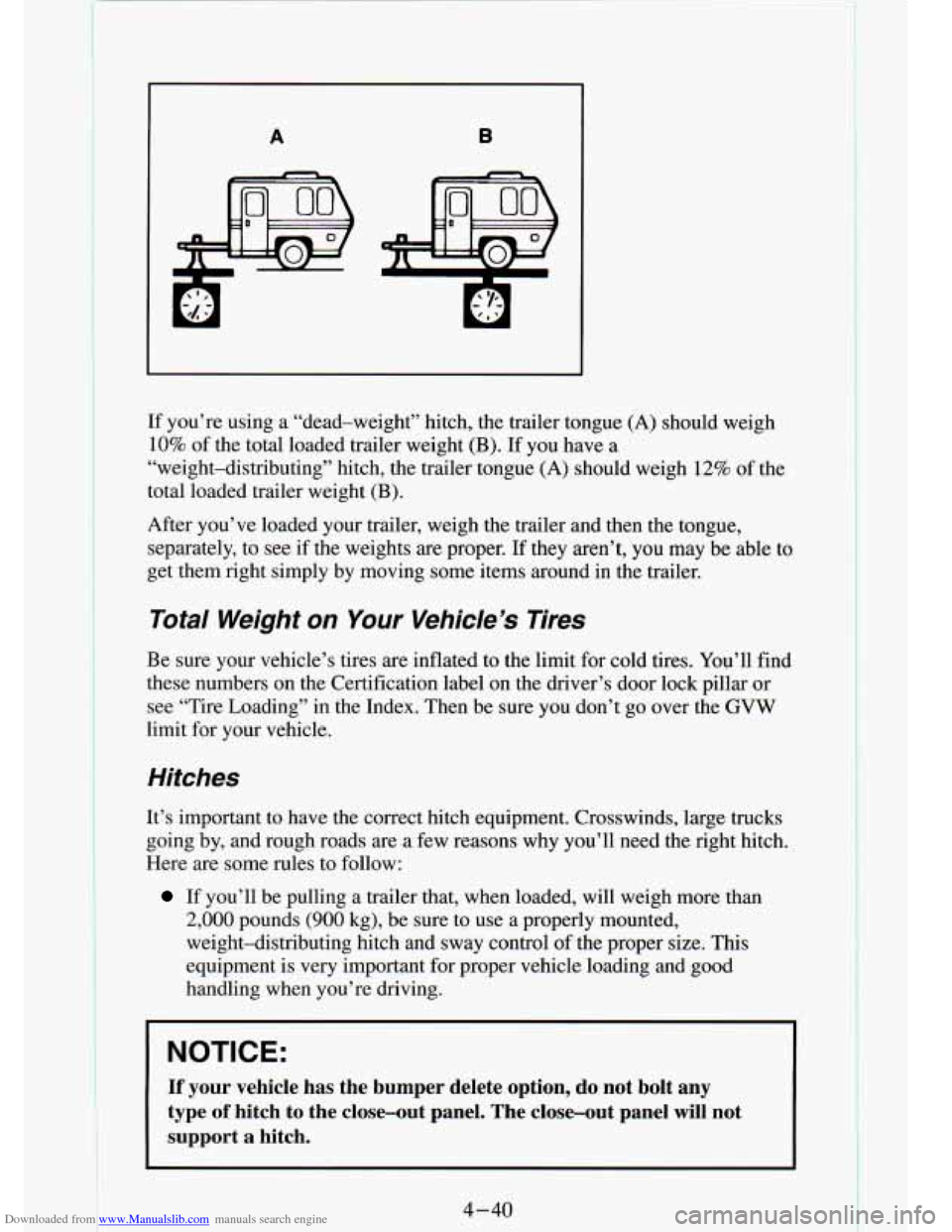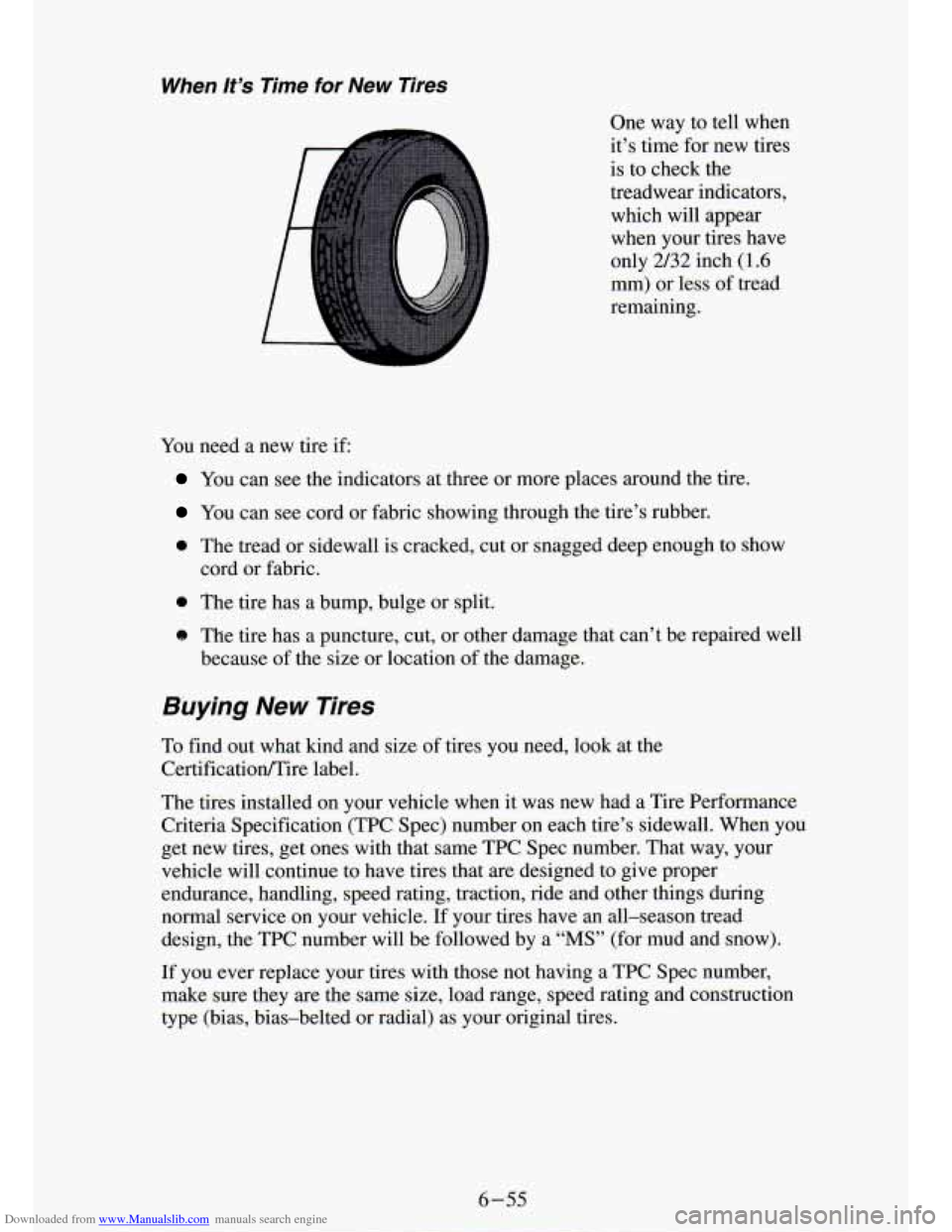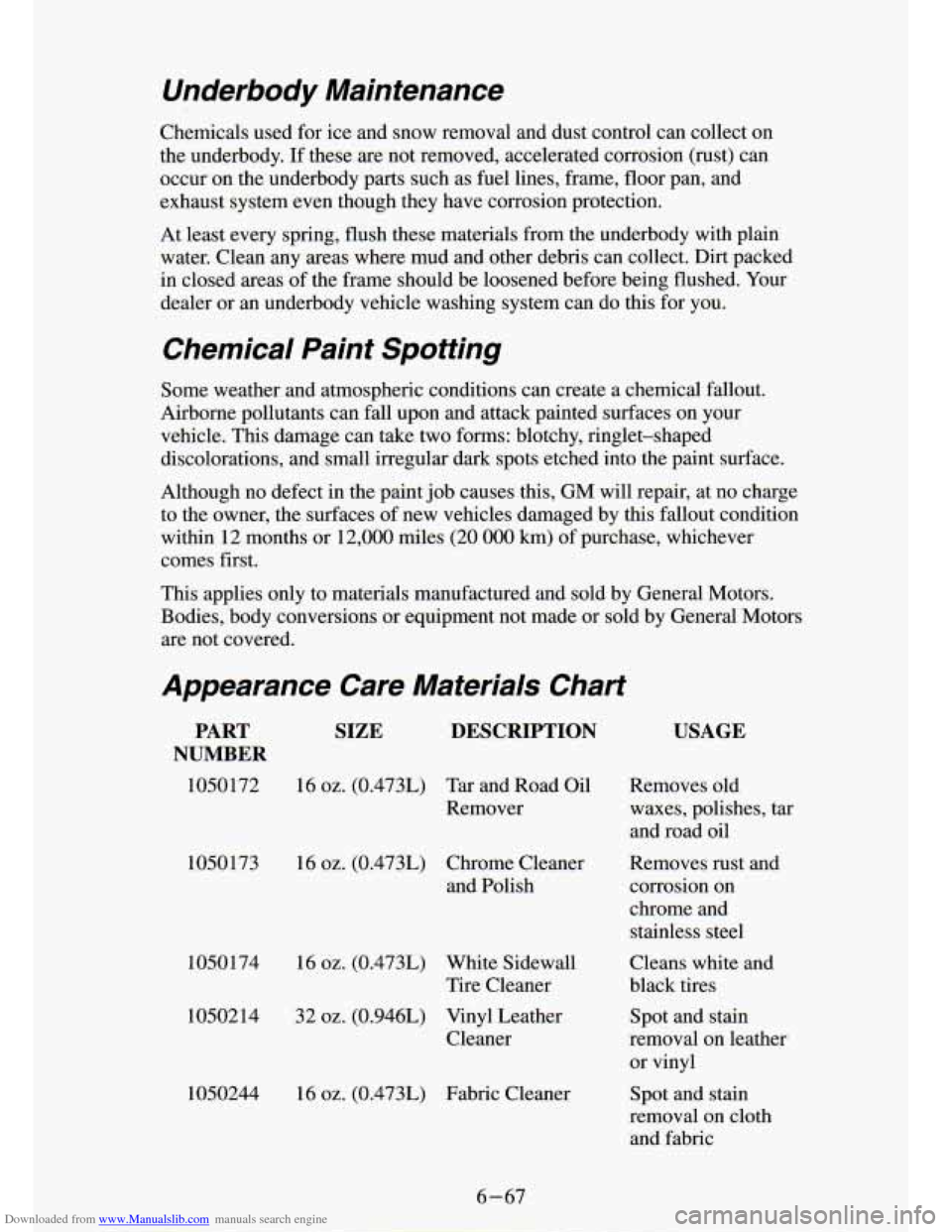1994 CHEVROLET S10 tire size
[x] Cancel search: tire sizePage 176 of 340

Downloaded from www.Manualslib.com manuals search engine A B
If you’re using a “dead-weight” hitch, the trailer tong\
ue (A) should weigh
10% of the total loaded trailer weight
(B). If you have a
“weight-distributing” hitch, the trailer tongue
(A) should weigh 12% of the
total loaded trailer weight (B).
After you’ve loaded your trailer, weigh the trailer and then\
the tongue, separately, to see if the weights are proper. If they aren’t,
you may be able to
get them right simply
by moving some items around in the trailer.
Total Weight on Your Vehicle’s Tires
Be sure your vehicle’s tires are inflated to the lirnit for cold tires. You’ll find
these numbers on the Certification label on the driver’s doo\
r lock pillar or
see “Tire Loading”
in the Index. Then be sure you don’t go over the GVW
limit for your vehicle.
Hitches
It’s important to have the correct hitch equipment. Crosswind\
s, large trucks
going by, and rough roads are a few reasons why you’ll nee\
d the right hitch.
Here are some rules to follow:
If you’ll be pulling a trailer that, when loaded, will weigh m\
ore than
2,000 pounds (900 kg), be sure to use a properly mounted,
weight-distributing hitch and sway control of the proper size. This equipment is very important for proper vehicle loading and good
handling when you’re driving.
NOTlCE:
If your vehicle has the bumper delete option, do not bolt any
type
of hitch to the close-out panel. The close-out panel will not
support
a hitch.
4-40
Page 263 of 340

Downloaded from www.Manualslib.com manuals search engine Engine Control Module System
This system has an oxygen (02) sensor that helps keep your engine’s
air-fuel mixture at a proper level. Use only unleaded fuel in your vehicle.
If
you use leaded fuel, you could damage your oxygen (02) sensor and affect
your vehicle’s emissions.
Loading Your Vehicle
The CertificatiodTire label is found on the driver’s door lock pillar. The
label shows the size of your original tires and the inflation pressures needed
to obtain the
gross weight capacity of your vehicle. This is called the
GVWR (Gross Vehicle Weight Rating). The GVWR includes the weight of
the vehicle,
all occupants, fuel and cargo.
The CertificatiodTire label
also tells you the maximum weights for the
front and rear axles, called Gross Axle Weight Rating
(GAWR). To find out
the actual
loads on your front and rear axles, you need to go to a weigh
station and weigh
your vehicle. Your dealer can help you with this. Be sure
to spread out your load equally
on both sides of the centerline.
Never exceed the GVWR for your vehicle, or the Gross Axle Weight Rating
(GAWR) for either the front or rear axle.
And, if you do have a heavy load, you should spread it out.
6-45
Page 273 of 340

Downloaded from www.Manualslib.com manuals search engine When lt’s Time for New Tires
a
One way to tell when
it’s time for new tires
is to check the
treadwear indicators,
which will appear
when your tires have
only
2/32 inch (1.6
mm) or less of tread
remaining.
You need a new tire if
You can see the indicators at three or more places around the tire.
You can see cord or fabric showing through the tire’s rubber.
0 The tread or sidewall is cracked, cut or snagged deep enough to show
cord or fabric.
0 The tire has a bump, bulge or split.
The tire has a puncture, cut, or other damage that can’t be re\
paired well
because of the
size or location of the damage.
Buying New Tires
To find out what kmd and size of tires you need, look at the
Certificatioflire label.
The tires installed on your vehicle when it was new had a Tire Performance
Criteria Specification (PC Spec) number on each tire’s sidewall. When you
get new tires, get ones with that same TPC Spec number. That way, your
vehicle will continue to have tires that
are designed to give proper
endurance, handling, speed rating, traction, ride and other thin\
gs during
normal service on your vehicle.
If your tires have an all-season tread
design, the TPC number will be followed by a
“MS” (for mud and snow).
If you ever replace your tires with those not having a
TPC Spec number,
make sure they are the same size, load range, speed rating and construction
type (bias, bias-belted or radial) as your original tires.
Page 277 of 340

Downloaded from www.Manualslib.com manuals search engine Tire Chains
NOTICE:
If your vehicle has P235/75R15 or 31xlOSOR15LT/C size tires,
don’t use tire chains; they can damage your vehicle.
If you have other size tires, use tire chains only where legal and
only when you must. Use only SAE Class “S” type chains that
are the proper size for your tires. Install them on the drive axle
tires (four-wheel-drive vehicles can use chains on both axles)
and tighten them as tightly
as possible with the ends securely
fastened. Drive slowly and follow the chain manufacturer’s
instructions.
If you can hear the chains contacting your vehicle,
stop and retighten them.
If the contact continues, slow down
until
it stops. Driving too fast with chains on will damage your
vehicle.
Appearance Care
Remember, cleaning’ products can be hazardous. Some are toxic\
. Others can
burst into flame
if you strike a match or get them on a hot part of the
vehicle. Some are dangerous
if you breathe their fumes in a closed space.
When you use anything from
a container to clean your vehicle, be sure to
follow the manufacturer’s warnings and instructions. And always open your\
doors or windows when you’re cleaning the inside.
6-59
Page 285 of 340

Downloaded from www.Manualslib.com manuals search engine Underbody Maintenance
Chemicals used for ice and snow removal and dust control can collect on
the underbody. If these are not removed, accelerated corrosion \
(rust) can
occur on the underbody parts such as fuel lines, frame, floor \
pan, and
exhaust system even though they have corrosion protection.
At least every spring, flush these materials from the underbody\
with plain water. Clean any areas where mud and other debris can collect.\
Dirt packed
in closed areas of the frame should be loosened before being flushed.
Your
dealer or an underbody vehicle washing system can do this for you.
Chemical Paint Spotting
Some weatherand atmospheric conditions can cre; a chemical fallout.
Airborne pollutants can fall upon and attack paintea surfaces on your
vehicle. This damage can take two forms: blotchy, ringlet-shape \
discolorations, and small irregular dark spots etched into the \
paint
sur - :e.
Although no defect in the paint job causes
this, GM will repair, at no charge
to the owner, the surfaces of new vehicles damaged by this fallout condition
within 12 months or 12,000 miles (20
000 km) of purchase, whichever
comes first.
-'
This applies only to materials manufactured and sold by General Motors.
Bodies, body conversions or equipment not made or sold by Gene\
ral Motors are not covered.
Appearance Care Materials Chart
PART SIZE DESCRIPTION
NUMBER
1050172 16 oz. (0.473L) Tar and Road Oil Removes old
Remover waxes, polishes, tar and road oil
16
oz. (0.473L) Chrome Cleaner Removes rust and and Polish corrosion on
chrome and
sta ess steel
1050173
1050174 16
oz. (0.473L) White Sidewall
Tire Cleaner
1050214 32
oz. (0.946L) Vinyl Leather
Cleaner
1050244 16
oz. (0.473L) Fabric Cleaner
USAGE
Spot and stain
removal on leather
or vinyl
Spot and stain
removal on cloth and fabric
6- 67
Page 286 of 340

Downloaded from www.Manualslib.com manuals search engine PART
NUMBER
1050427
SIZE DESCRIPTION
23 oz. (0.680L) Glass Cleaner
1050429 6 lbs. (2.72 kg) Multi-Purpose Powder Cleaner
1050729
USAGE
Glass cleaning and spot cleaning on
vinyls
Cleans vinyl and
cloth on door
trim,
seats, and
carpet-also tires
and mats
8 oz. (0.237L) Vinyl Top Cleaner Cleaning of vinyl
tops
1051055 16
oz. (0.473L) Preservatone
1051398
8 oz. (0.237L) Spot Lifter Vinyl top dressing
Spot and stain
removal on cloth
and fabric
1052870 16
oz. (0.473L) Wash-Wax (conc.) Exterior wash
1050201 16
oz. (0.473L) Magic Mirror Cleaner-Polish Exterior cleaner
and polish
Vehicle Identification Number (VIN)
I
This is the legal identifier for your vehicle. It appears on a plate in the front
corner
of the instrument panel, on the driver's side. You can see it if you
look through the windshield from outside your vehicle. The
VIN also
appears on the Vehicle Certification and Service Parts labels a\
nd the
certificates of title and registration.